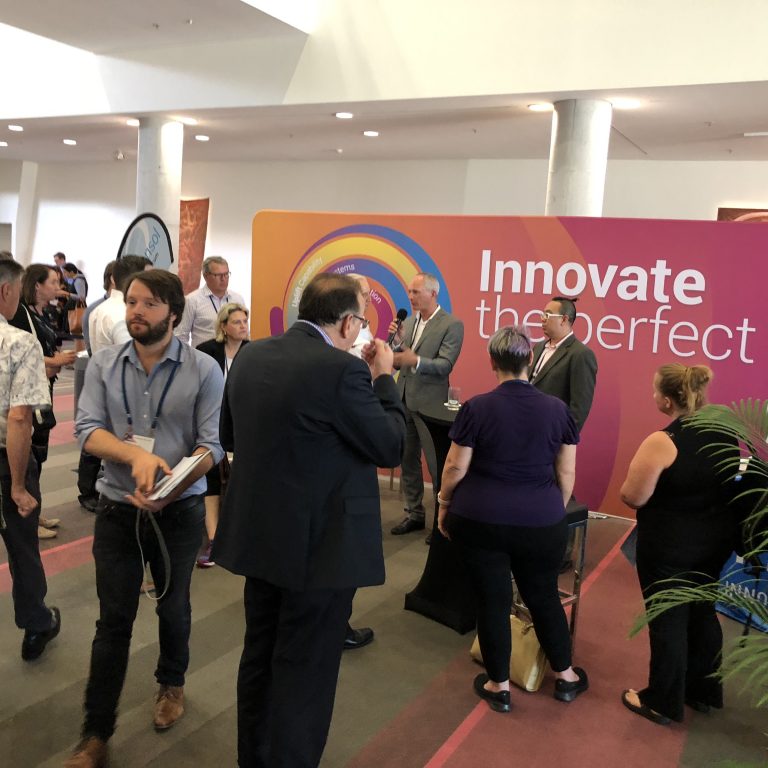The title is an adapted version of Bill Gates’ now famous quote “We always overestimate the change that will occur in the next two years and underestimate the change that will occur in the next ten. Don’t let yourself be lulled into inaction.” I heard this used in the recent Social Innovation Forum hosted by Hitachi, and it also sums up the Futures Thinking Strategy course for which I was pleased to be a student earlier this month. The Futures Thinking Strategy course ran over three days at the Gold Coast and I can comfortably admit that it blew my mind. The magnitude of the shift in our method of thinking during the course sufficiently made all the strategy and day-to-day operations of our business seem like small fry compared with what we can be imagining in the future.
Doing both the course and the Innovation forum in one week certainly forced me to stop and “take stock” of the company’s trajectory. In fact it forced me to look at my own trajectory as well but that’s for another time. You see, Futures Thinking or Foresight as some call it endeavours to use tools and techniques to push organisations or individuals to imagine future scenarios. Not in two years’ time. Not even in five years’ time. But in more than 10! It’s by no means a crystal ball. Instead it uses proven historical, psychological and systematic techniques to “mine” futures out of the collective. From there, strategies and policies can form and flow from it. It’s not as “out there” as you might think. As I’ve begun to realise, being a “Futurist” is a very specialised and professional field (google it!). Many large organisations and governments have been using Futurist advisors and time and time again, it seems that many of the future predictions that may seem impossible or silly at the time they are imaginged, are not too far off the mark.
For three days amongst the training, we talked about the future of milk since synthetic milk is now possible (yep, it’s real). We imagined scenarios where capitalism falls and there’s a shared economy where IP, research and technology are free of charge and freely available. We thought of scenarios where we can healthily live to 100 years old and how that impacts our world. So how do different (but possible) futures like this impact the here and now? How does the alternative future impact us in our now seemingly small little world of office politics, fire-fighting and implementing software? “We’re barely keeping afloat!”, you might say. This is where Bill Gates’ quote comes in. We’re pretty good at over planning and worrying about what’s in front of us, with our blinkers on, but don’t have time to look at the horizon (Zero-loop thinking, according to the course). And even if we do think to the future, we use the same information and known experience to try and come up with solutions (Single-loop thinking). Futurists try to shift mindset to what is known as Double-loop thinking, where we have to “rewire” our minds (mental model) to accommodate new pathways. On our first day of training, this simple theory explained so much about why we (both personally and corporately) like to reinvent the wheel; copy but often “hit our head against the wall” in hopes that we can do it better the next time!
In this recount I’m only scratching the surface of what Futures Thinking is and what those of us in leadership, transformation or change roles can do to take on board its principles. However, one thing I can say with confidence is that we all need to get out of the mode of Single-loop thinking, believing that this mode of approaching change and transformation is enough to make it happen in the best way. No longer being a slave to Single-loop thinking will be a profound and sufficient first step. There is no point to do more innovation, anticipate disruption or imagine transformations if we don’t truly appreciate that dressing something up in green instead of blue, won’t work.
The David and Goliath scenario and the parallel to Double-loop thinking.
Why are start-ups beating the corporates? Because start-ups are forced into Double-loop thinking to survive. And why care about this? Because whether you like it or not, the world is getting more populated, technology is advancing at an exponential rate and professions are dying out due to things like AI and automation. The world is changing at a pace that’s never been seen before and businesses are demanding cheaper, better and faster products and services. Doing the same stuff but faster – may not be good enough anymore. “Let’s do something different, but I don’t know how to change” is currently the epidemic!
So my key takeaway for those of you who made it this far in the article…embrace the idea of futurism; encourage your organisation to bring in experts in this field and watch your people’s minds get blown (in a good way).
About the Author
Mervin Chiang
CTIO, Procensol
As Procensol’s Chief Technology and Innovation Officer Mervin brings more than a decade of experience in strategic thinking, software, systems and process-centric design for business transformation. Mervin is responsible for Procensol’s global consulting services and product portfolio. He is also responsible for global marketing and driving growth within the Asia Pacific region. Originally from Singapore and now based in Brisbane Australia, Mervin has held positions ranging from strategic BPM consulting, channel management to vendor product sales.
Related Posts

Innovation-as-Usual
“Nobody gets excited if you elaborate on what’s broken…” Professor Michael Rosemann joins us on the Procensol and MBT booth at BiiG 2017 to discuss…
Read More
Culture and leadership for continuous innovation
evidence suggests that traditional approaches to developing a culture of innovation are not sustainable as they do not address key inhibitors such as operational systems and processes that cannot support continuous change. To establish a culture of innovation, organisations need to: secure executive approval and leadership; engage their employees; and optimise and align their internal business operations by exploring technological advancements.
Read More

